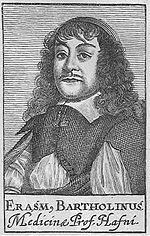Rasmus Bartholin
From Wikipedia, the free encyclopedia
| Rasmus Bartholin | |
|---|---|
 Rasmus Bartholin | |
| Born | 13 August 1625 Roskilde |
| Died | 4 November 1698 (aged 73) Kopenhagen |
| Nationality | Danish |
| Fields | Physics |
| Known for | double refraction of a light ray |
Rasmus Bartholin is remembered especially for his discovery (1669) of the double refraction of a light ray by Iceland spar (calcite).[1] He published an accurate description of the phenomenon, but since the physical nature of light was poorly understood at the time, he was unable to explain it. It was only after Thomas Young proposed the wave theory of light, c. 1801 that an explanation became possible.
[edit] Important Facts
1. DatesBorn: Roskilde, Denmark, 13 Aug. 1625
Died: Copenhagen, 4 Nov. 1698
Dateinfo: Dates Certain
Lifespan: 73
2. Father
Caspar Bartholin
Occupation: Physician, Academic
He died when Erasmus was four. No clear information on financial status.
3. Nationality
Birth: Roskilde, Denmark
Career: Denmark
Death: Copenhagen, Denmark
4. Education
Taught initially by private teachers, then attended Latin school.
Univ. of Copenhagen (1642-4), B.A. in 1644. M.A. in 1647.
Studied mathematics at the University of Leiden for several years beginning in 1645.
1651: studied mathematics in France and Italy, ultimately at the Padua where he was Consiliarius for the German Nation and Vice-syndicus for the university.
M.D., 1654 at Padua.
1654-6: travelled and studied in Italy.
5. Religion
Affiliation: Lutheran.
6. Scientific Disciplines
Primary: Mathematics, Optics
Subordinate: Medicine, Astronomy
Major contribution to science was his study of Icelandic spar.
Writings in pure mathematics were fairly numerous but not of great importance.
Wrote a little on medicine.
Observed the comets of 1665 and other astronomical objects, and published about this topic.
7. Means of Support
Primary: Academia, Patronage, Government
Professor of mathematics at Copenhagen, 1657.
Extraordinary chair of medicine, 1657.
Royal Mathematician, 1667.
Ordinary chair of medicine, 1671.
Teacher to Prince Joergen, 1671.
Dean of the faculty of medicine.
Librarian.
Rector in three different years.
Royal physician.
Privy concilor, Advisor to the chancellor, then minister of justice.
8. Patronage
Type: Court Official
He was supported and directed by Frederick III of Denmark to prepare for publication the collected manuscript observations of Tycho Brahe.
In addition, all of the connections to the court, and the various appointments above.
9. Technological Involvement
Type: Medical Practice
As a physician, he introduced quinine in the fight against malaria.
10. Scientific Societies
Memberships: None
He worked with Ole Roemer on Tycho's manuscripts.
He worked with Niels Stensen on crystallography.
[edit] References
- ^ Erasmus Bartholin, Experimenta crystalli islandici disdiaclastici quibus mira & insolita refractio detegitur (Copenhagen ("Hafniæ"), Denmark: Daniel Paulli, 1669). English translation: Experiments with the double refracting Iceland crystal which led to the discovery of a marvelous and strange refraction, tr. by Werner Brandt. Westtown, Pa., 1959.
[edit] External links
- O'Connor, John J.; Robertson, Edmund F., "Rasmus Bartholin", MacTutor History of Mathematics archive, University of St Andrews, http://www-history.mcs.st-andrews.ac.uk/Biographies/Bartholin.html.
- http://www.experiencefestival.com/erasmus_bartholinus/articleindex
- http://www.britannica.com/EBchecked/topic/54330/Erasmus-Bartholin
- http://www.worldcat.org/identities/lccn-n93-3891
- http://www-history.mcs.st-and.ac.uk/Biographies/Bartholin.html
No comments:
Post a Comment